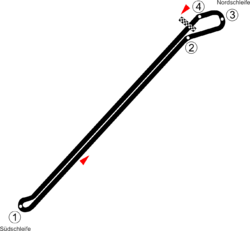Difference between revisions of "Avus"
m |
m |
||
| Line 1: | Line 1: | ||
| − | + | {{X}} | |
[[Image:Circuit AVUS.png|thumb|250px|{{flagiconGermany}} '''AVUS [[Berlin]], [[Germany]]''']] | [[Image:Circuit AVUS.png|thumb|250px|{{flagiconGermany}} '''AVUS [[Berlin]], [[Germany]]''']] | ||
| + | |||
The '''Automobil-Verkehrs- und Übungs-Straße''', better known as '''AVUS''', was a [[Auto racing|motor racing]] circuit on the south-western outskirts of [[Berlin]], [[Germany]], between [[Charlottenburg]] and [[Nikolassee]]. | The '''Automobil-Verkehrs- und Übungs-Straße''', better known as '''AVUS''', was a [[Auto racing|motor racing]] circuit on the south-western outskirts of [[Berlin]], [[Germany]], between [[Charlottenburg]] and [[Nikolassee]]. | ||
Latest revision as of 16:40, 6 July 2009
The Automobil-Verkehrs- und Übungs-Straße, better known as AVUS, was a motor racing circuit on the south-western outskirts of Berlin, Germany, between Charlottenburg and Nikolassee.
Nowadays, it is an important part of the public highway system, as Autobahn A 115. While normal for a road, it is unusually shaped for a race track as it is essentially just two long straights in the form of a dual carriageway, with a hairpin corner at each end.
History 1907-1939
The circuit through the Grunewald forest was devised by the Automobilclub von Deutschland (AvD), in 1907, as both a motor-sport venue and a testing track for the motor industry. A lack of finances delayed the start of construction for six years, and construction was halted in 1913 for the same reason. During the Great War, Russian prisoners were employed in AVUS's construction, but the track was still unfinished by 1918. The remaining work was financed by business man Hugo Stinnes, and the circuit opened in September 1921.
At the time of opening, AVUS was 19.5 km (12 miles) long - each straight being approximately half that length, and joined at each end by flat large radius curves, driven counter-clockwise. In 1926 the track played host to the first German Grand Prix for sports cars (won by Rudolf Caracciola in a Mercedes-Benz).
Since 1927 the AVUS faced competition from the new Nürburgring circuit. In an effort to make AVUS the world's fastest race track, the north curve was turned into a steep banking (43°) made of bricks. The Silver Arrows of Mercedes-Benz and Auto Union raced only once on the banked version, in 1937, using streamlined cars as in their high speed record attempts. Hermann Lang's average race speed of about 260 km/h was not beaten at Indianapolis Indy 500 for 3 decades.
In early 1938, the popular German race driver Bernd Rosemeyer was killed in a land speed record attempt (not at the AVUS, but on a similar straight of the Autobahn Frankfurt/Darmstadt), and the high speed AVUS was then considered too dangerous for the fast Grand Prix race cars. Also, it was planned to connect the AVUS to the growing Reichsautobahn network by extending it to the south, so the South Turn at Nikolassee was demolished and replaced by a junction.
History 1947-1967
After World War II, the Soviet quarter and the Berlin Wall with its Checkpoint Bravo at Dreilinden/Drewitz came no closer than about one mile to the former South Turn. It is a common yet wrong belief that the Berlin Wall had cut the AVUS in half. For post-war racing, the original extremely long straights were shortened by the introduction of a new south turn roughly in the middle (just before the exit at Hüttenweg, were it can still be seen nowadays), reducing the track length to 8.3 km (just over 5 miles).
In 1954, this shorter track hosted a non-championship Formula One race which was mainly a show by the Mercedes-Benz team, as no serious competition was present. In 1959, AVUS hosted its only world championship F1 with the 1959 German Grand Prix, won by Tony Brooks. This race weekend also saw the death of Jean Behra, as his Porsche flew over the top of the north turn banking, as there was no wall or fence. German driver and journalist Richard von Frankenberg had walked away from a similar spectacular crash.
This banking, which was considered dangerous by international racing standards, was dismantled in 1967 to give way to an expanded intersection under the Funkturm tower. From the top of this tower, one can see that the AVUS is not perfectly straight.
History 1967-1998
Racing was continued with a flat north turn, but AVUS only held national touring cars DTM and Formula 3 events. The length of the track was roughly cut in half twice in the 1980s and 1990 as racing on straights became unpopular. Also, chicanes were added to reduce entry speed into the North Curve. Yet, some incidents and accidents occurred. The BMW of Dieter Quester rolled over when exiting the last corner, and crossed the finish line sliding on its roof, with sparks flying, for a podium finish. The car of John Winter hit a barrier and exploded into a fireball in North Curve which he survived. In 1995, the race 2 of DTM had to be cancelled, after a multi-car pileup blocked the circuit and later in September, British driver Kieth Odor was killed when his car spun and was rammed sideways.
After the fall of the Berlin wall, the closure of the AVUS for race events became more and more problematic. The last real races were in 1998.
History since 1999
In 1999, a farewell event with veterans was held. From 2000 on, the new EuroSpeedway Lausitz in Brandenburg is considered the replacement for AVUS.
The round race control tower (with prominent Mercedes-Benz and Bosch sponsorship) still remains at the north end, and is used as a public restaurant and Motel. The old wooden grandstand is protected as a historic monument.
See also
External links
- http://www.eurospeedway.de (in German)
